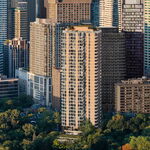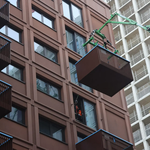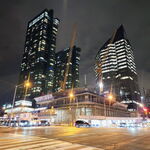Can people please stop with quote wars? You can quote the thesis statement only and get more or less the same effect, you don't need to respond to each and every point directly. They are a real PITA to read through, for me at least. Anything with more than 4-5 quotes just seems excessive.
Here's my summed-up argument:
Reasons for a Wellington-Rail alignment and against the Queen Alignment:
1) Serves up-and-coming neighbourhoods of Liberty Village, CityPlace, West Donlands, and the Portlands (to a certain extent).
1)b) Queen St is a stable neighbourhood, with limited redevelopment potential (ie a single strip of RC that is severely limited in height)
2) Redevelopment potential along the rail corridor provides even more brownfield development opportunities. Unused or underused industrial sites are a goldmine for redevelopment if a subway was in place.
3) The DRL needs a fairly large distance between stops. Using the rail corridor can accomplish this, because by and large it is only crossed at major arterials.
3)b) Queen is a localized street, and therefore needs localized transit. The options for a DRL along Queen are either a) closer station stops (akin to B-D), or b) larger gaps between station stops. The former would drastically reduce the speed (and effectiveness) of the DRL, and the latter would not be responding appropriately to the localized nature of the street (just look at Yonge between Eglinton and Lawrence, retail in the middle is worse off than retail closer to the stations).
4) A Wellington alignment through the car addresses the importance of including Union station in the alignment, but does not rely soley on it. The creation of 3 new platforms (Union @ Wellington between Bay and York, south end of King platform from Yonge to Church, and south end of St. Andrew platform from University to Duncan) better distributes this peak hour load of passengers, both on the subway system and the pedestrian network.
4)b) A Queen alignment would provide access to the Eaton Centre, Opera House, etc (as was previously stated). However, these are not large peak-hour generators. The Eaton Centre already has 2 subway stations directly connected to it. Access to the Eaton Centre is not an issue.
5) Using Wellington and the rail corridor will cause significantly less disruption that using Queen. Wellington is not a major transit route, nor is it even really a major street. Compared to losing Queen, Richmond, Adelaide, or King for a couple years, Wellington is the best option. Many of the parking garages that use Wellington also have exits onto King or Front, so they will be able to still function. Streetcar service on King and Queen will be unaffected during construction.
Using the rail corridor outside of the downtown will allow for it to travel along at surface level for periods. There is the other option of building the DRL as an elevated line overtop of the existing rail line. This would eliminate the need to tunnel, and would disrupt rail traffic below even less. This would be especially good for station sections, as building an elevated station is degrees of magnitude less expensive than building an underground station.
5)b) Using Queen would involve shutting down sections of Queen for years at a time. The streetcar service would have to be re-routed onto a combination of Richmond and Adelaide, which business owners would not care for. Also, the larger station stop spacing that would result would be unfair to business owners who used to have a streetcar stop right in front of their door, but now have to walk 300m to reach the nearest station.
The short version: Queen street needs an LRT subway with closer station spacing. The DRL needs an HRT subway with larger station spacing in order to be faster, and to effectively relieve Bloor-Yonge. The two are incompatible, and trying to fit a square peg into a round hole will not work. They are completely separate projects with separate ultimate objectives, they should not be mixed, and compromised into something that is sub-optimal for BOTH projects.
The short, short version: Queen not right. Build DRL somewhere else.




